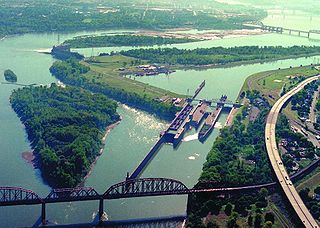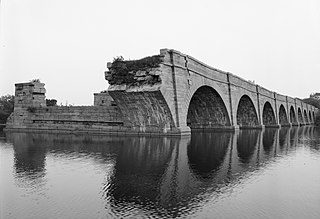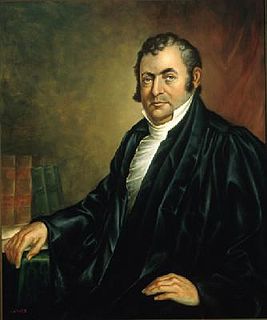
The Ohio River is a 981-mile (1,579 km) long river in the United States. It is located in the midwestern United States, flowing southwesterly from western Pennsylvania south of Lake Erie to its mouth on the Mississippi River at the southern tip of Illinois. It is the third largest river by discharge volume in the United States and the largest tributary by volume of the north-south flowing Mississippi River that divides the eastern from western United States. The river flows through or along the border of six states, and its drainage basin includes parts of 15 states. Through its largest tributary, the Tennessee River, the basin includes several states of the southeastern U.S. It is the source of drinking water for three million people.

Daniel Boone was an American pioneer, explorer, woodsman, and frontiersman whose frontier exploits made him one of the first folk heroes of the United States. Although he also became a businessman, soldier and politician who represented three different counties in the Virginia General Assembly following the American Revolutionary War, Boone is most famous for his exploration and settlement of what is now Kentucky. Although on the western side of the Appalachian Mountains from most European-American settlements, Kentucky remained part of Virginia until it became a state in 1791.

A pusher, pusher craft, pusher boat, pusher tug, or towboat, is a boat designed for pushing barges or car floats. In the United States, the industries that use these vessels refer to them as towboats. These vessels are characterized by a square bow, a shallow draft, and typically have knees, which are large plates mounted to the bow for pushing barges of various heights. These boats usually operate on rivers and inland waterways. Multiple barges lashed together, or a boat and any barges lashed to it, are referred to as a "tow" and can have dozens of barges. Many of these vessels, especially the long distances, or long haul boats, include living quarters for the crew.

The Transylvania Colony, also referred to as the Transylvania Purchase, was a short-lived, extra-legal colony founded during 1775 by land speculator Richard Henderson, who controlled the North Carolina-based Transylvania Company. Henderson and his investors had reached an agreement to purchase a vast tract of Cherokee lands west of the southern and central Appalachian Mountains through the acceptance of the Treaty of Sycamore Shoals with most leading Cherokee chieftains then controlling these lands. In exchange for the land the tribes received goods worth, according to the estimates of some scholars, about 10,000 British pounds. To further complicate matters, this early American frontier land was also claimed at the same time by both the Province of Virginia and the North Carolina colony.

The Green River is a 384-mile-long (618 km) tributary of the Ohio River that rises in Lincoln County in south-central Kentucky. Tributaries of the Green River include the Barren River, the Nolin River, the Pond River and the Rough River. The river was named after Nathanael Greene, a general of the American Revolutionary War.

The Kentucky River is a tributary of the Ohio River, 260 miles (418 km) long, in the U.S. Commonwealth of Kentucky. The river and its tributaries drain much of the central region of the state, with its upper course passing through the coal-mining regions of the Cumberland Mountains, and its lower course passing through the Bluegrass region in the north central part of the state. Its watershed encompasses about 7,000 square miles (18,000 km2). It supplies drinking water to about one-sixth of the population of the Commonwealth of Kentucky.

Boonesborough is an unincorporated community in Madison County, Kentucky, USA. It lies in the central part of the state along the Kentucky River and is the site of Fort Boonesborough State Park, which includes the Kentucky River Museum. The park site has been rebuilt to look like a working fort of the days when Boone resided there.

The Wilderness Road was one of two principal routes used by colonial and early national era settlers to reach Kentucky from the East. Although this road goes through the Cumberland Gap into southern Kentucky and northern Tennessee, the other is sometimes called the "Cumberland Road" because it started in Fort Cumberland in Maryland. Despite Kentucky Senator Henry Clay's advocacy of this route, early in the 19th century, the northern route was selected for the National Road, connecting near Washington, Pennsylvania into the Ohio Valley of northern Kentucky and Ohio.

The McAlpine Locks and Dam are a set of locks and a hydroelectric dam at the Falls of the Ohio River at Louisville, Kentucky. They are located at mile point 606.8 and control a 72.9 miles (117.3 km) long navigation pool. The locks and their associated canal were the first major engineering project on the Ohio River, completed in 1830 as the Louisville and Portland Canal, designed to allow shipping traffic to navigate through the Falls of the Ohio.
U.S. Route 227 was a U.S. Highway that was commissioned in Kentucky from 1928 to 1972, and ran from Richmond to Carrollton.

The capture and rescue of Jemima Boone and the Callaway girls is a famous incident in the colonial history of Kentucky. They were captured by a Cherokee-Shawnee raiding party and rescued by Daniel Boone and his party, celebrated for their success. The incident was portrayed in 19th-century literature and paintings: James Fenimore Cooper created a fictionalized version of the episode in his novel The Last of the Mohicans (1826). The incident was the subject of a painting entitled The Abduction of Boone's Daughter by the Indians by Charles Ferdinand Wimar.

Boone Station State Historic Site was a 46-acre (190,000 m2) Kentucky State Historic Site on Boone's Creek near Athens in Fayette County, Kentucky, USA.

The Siege of Boonesborough took place in September 1778 during the American Revolutionary War. The attack on the Kentucky settlement of Boonesborough was led by Chief Blackfish, a Shawnee leader allied to the British. Months before the battle, Blackfish had captured and adopted Daniel Boone, the founder of Boonesborough. Boone escaped the Shawnees in time to lead the defense of the settlement. Blackfish's siege was unsuccessful and was lifted after ten days. Boone was then court-martialed by fellow officers who suspected him of having British sympathies. Boone was acquitted, but he soon moved away from Boonesborough.

Fort Boonesborough was a frontier fort in Kentucky, founded by Daniel Boone and his men following their crossing of the Kentucky River on April 1, 1775. The settlement they founded, known as Boonesborough, Kentucky, is Kentucky's second oldest European-American settlement. It served as a major frontier outpost during the American Revolutionary War, and survived into the early 19th century before its eventual abandonment. A National Historic Landmark now administered as part of Fort Boonesborough State Park, the site is one of the best-preserved archaeological sites of early westward expansion by British colonists in that period. It is located in Madison County, Kentucky off Kentucky Route 627.

"Indian Reserve" is a historical term for the largely uncolonized area in North America acquired by Great Britain from France through the Treaty of Paris (1763) at the end of the Seven Years' War, and set aside in the Royal Proclamation of 1763 for use by Native Americans, who already inhabited it. The British government had contemplated establishing an Indian barrier state in the portion of the reserve west of the Appalachian Mountains, and bounded by the Ohio and Mississippi rivers and the Great Lakes. British officials aspired to establish such a state even after the region was assigned to the United States in the Treaty of Paris (1783) ending the American Revolutionary War, but abandoned their efforts in 1814 after losing military control of the region during the War of 1812.
Peter Hackett was born in approximately 1763 or 1764 in the English colony of Virginia. It is believed that Peter was the son of Thomas Hackett, likely of Montgomery County, Virginia. As a boy Peter was bonded out to Captain James Estill, in approximately 1771, and was a part of the broad Scotch-Irish migration along the Wilderness Road through the Cumberland Gap from Virginia into what later became known as Kentucky in the late 18th century. In 1779 he was a resident of Boonesborough, one of the first English-speaking settlements beyond the Appalachian Mountains, and lived there until 1780. Early residents of Boonesborough included Daniel Boone, James Estill, Joseph Proctor, Nicholas Proctor, Adam Caperton, David Lynch, John Colefoot, John Moore, George Robertson, Thomas Miller, Reuben Proctor, Thomas Warren, Peter Hackett, and Thomas Watson. In 1780 Hackett helped establish Estill's Station, Kentucky, and lived there until about 1788.

Schoharie Crossing State Historic Site, also known as Erie Canal National Historic Landmark, is a historic district that includes the ruins of the Erie Canal aqueduct over Schoharie Creek, and a 3.5-mile (5.6 km) long part of the Erie Canal, in the towns of Glen and Florida within Montgomery County, New York. It was the first part of the old canal to be designated a National Historic Landmark, prior to the designation of the entire New York State Barge Canal as a NHL in 2017.

The historic Savannah – Ogeechee Barge Canal is one of the prime relics in the history of southern canals. Beginning with the tidal lock at the Savannah River, the waterway continues through four lift locks as it traverses 16.5 miles (26.6 km), before reaching another tidal lock at the Ogeechee River at Fort Stewart. Along the way, the canal passed through Savannah’s 19th century industrial corridor, former rice fields, timber tracts, and a still lush tidal river swamp and adjacent sandhill environment that is the characteristic habitat for several unique species of flora and fauna. Nowadays much of this area comprises the Savannah suburbs of Garden City and Pooler. The canal was added to the National Register of Historic Places on August 11, 1997.

Robert Trimble was a lawyer and jurist who served as Justice of the Kentucky Court of Appeals, as United States District Judge of the United States District Court for the District of Kentucky and as Associate Justice of the Supreme Court of the United States from 1826 to his death in 1828. During his brief Supreme Court tenure he authored several majority opinions, including the decision in Ogden v. Saunders, which was the only majority opinion that Chief Justice John Marshall ever dissented from during his 34 years on the Court.
Samuel South was born circa 1770 in Maryland. He was the second son of John South. The South family moved to Boonesborough when Samuel was still young. At the time, Boonesborough was in Fayette County in the District of Kentucky, a part of the state of Virginia. John South was in command of the militia at Boonesborough.
















